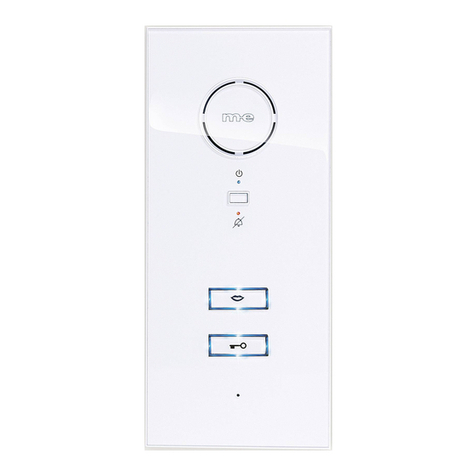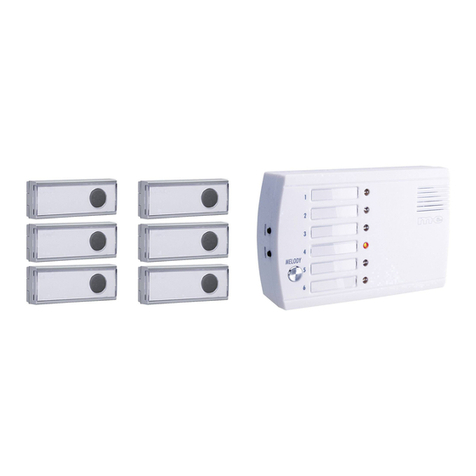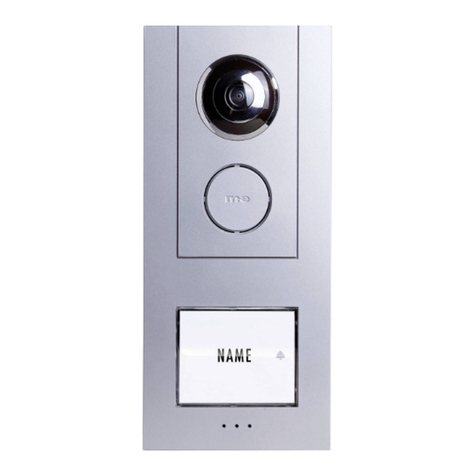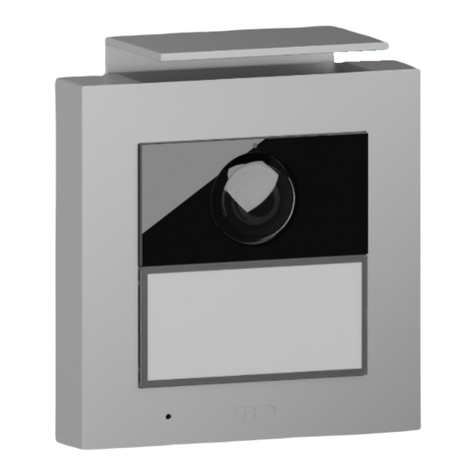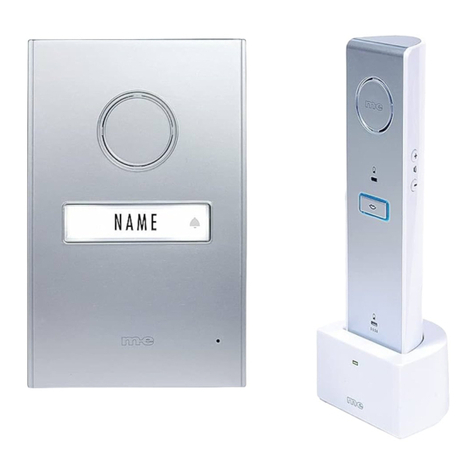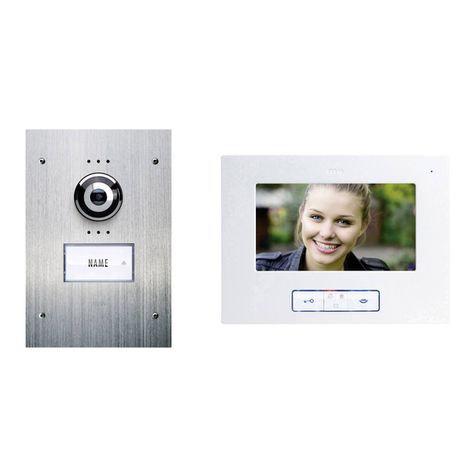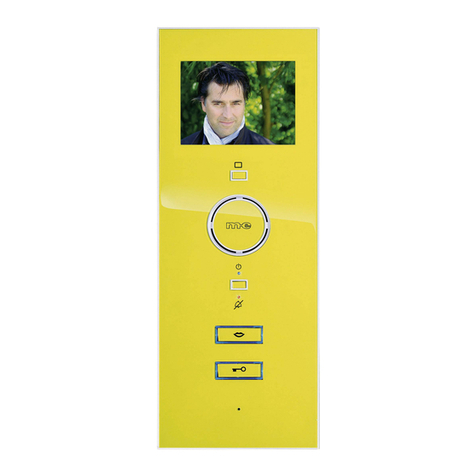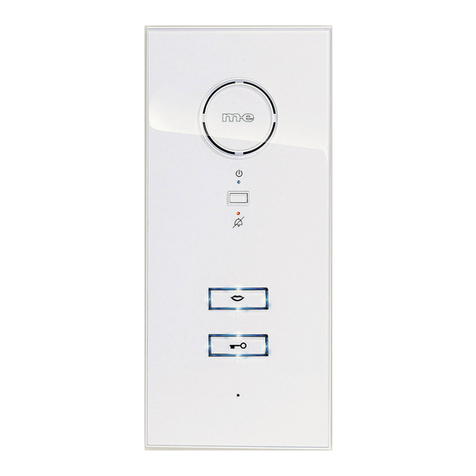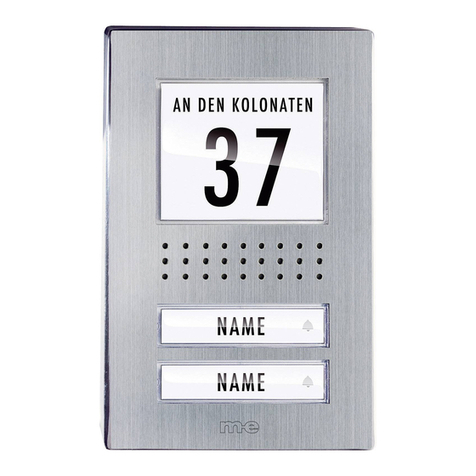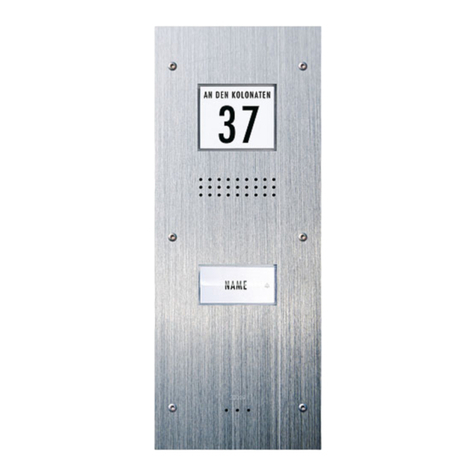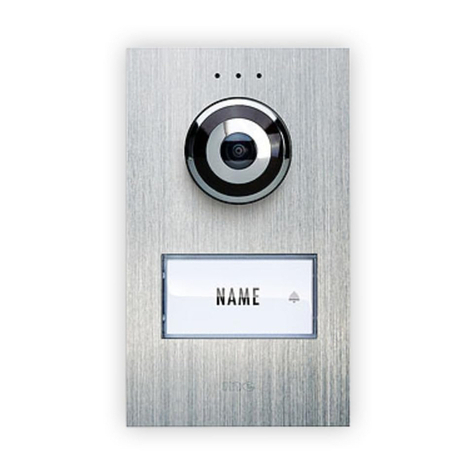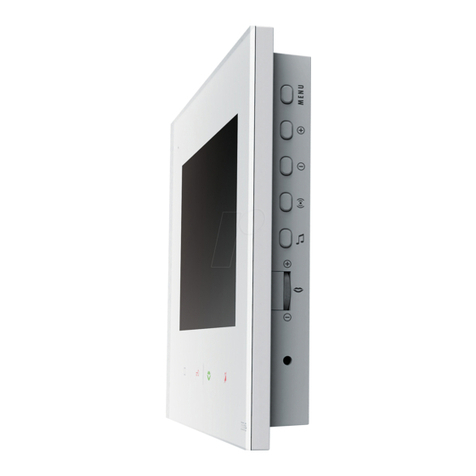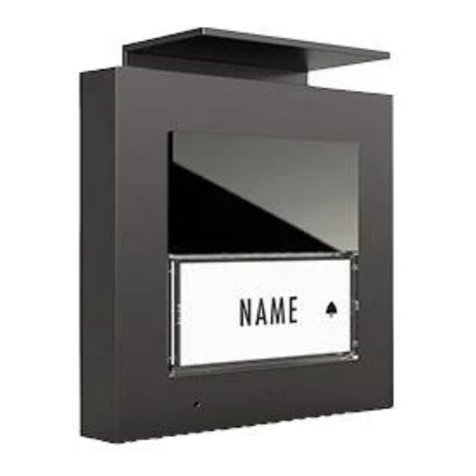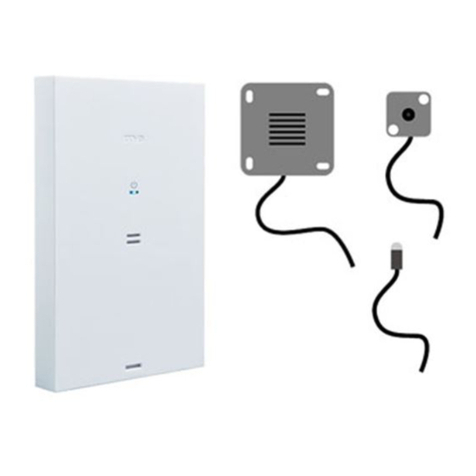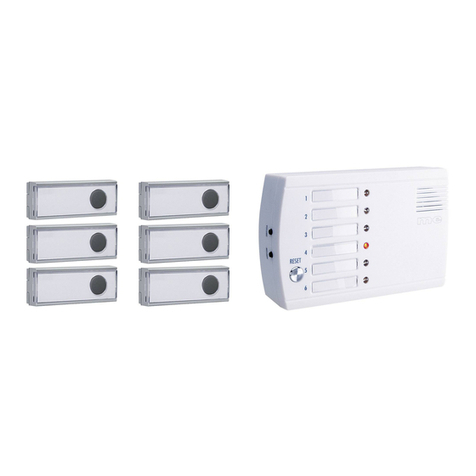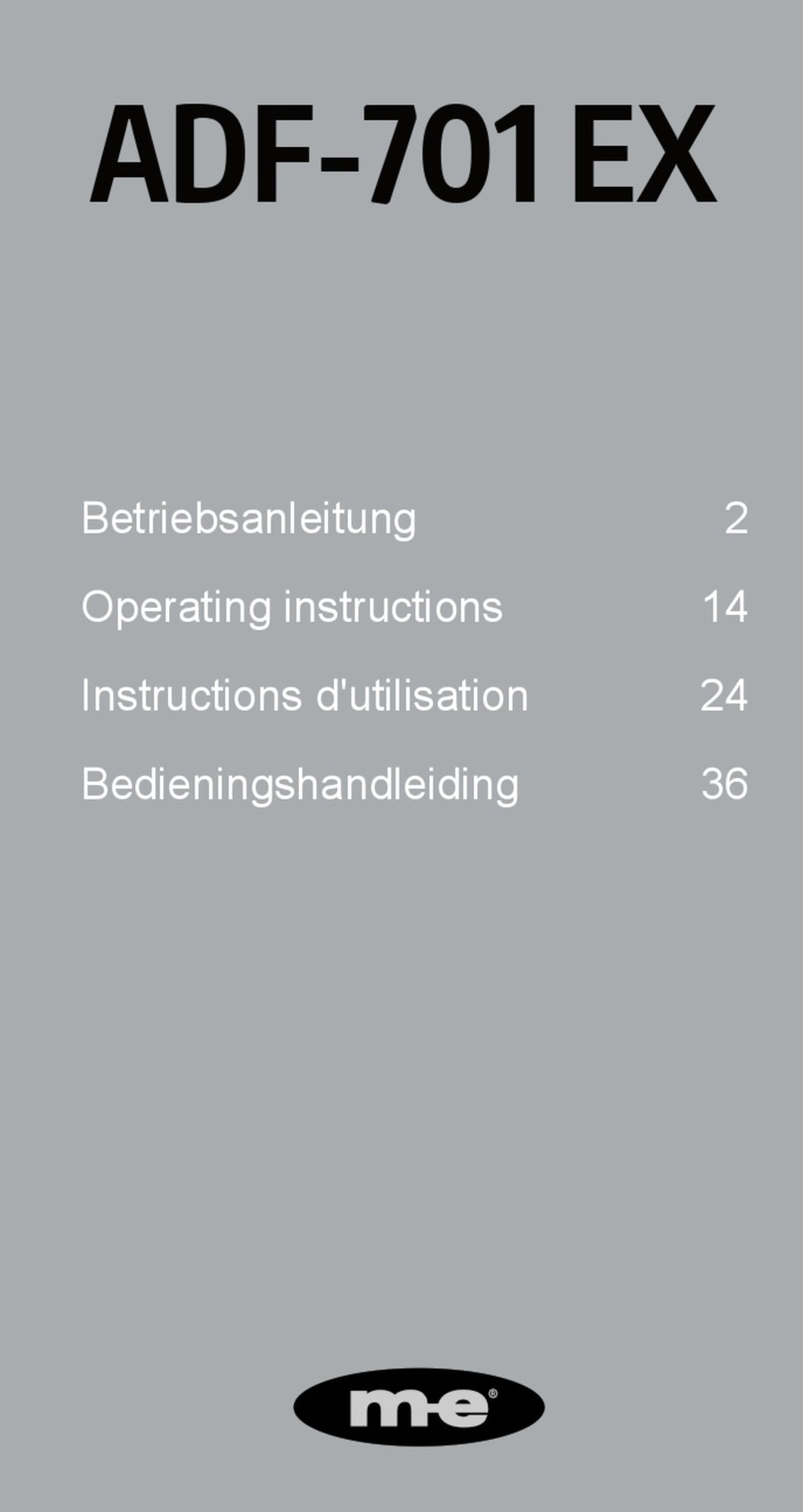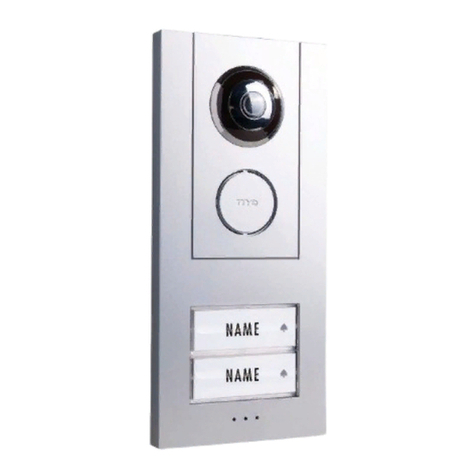
DEUTSCH | VISTUS VD
7
HINWEIS: Falls das VTX-BELL-Modul genutzt wird, so wird dieses im
Ruhemodus auch deaktiviert, d.h. die angeschlossenen Empfänger
geben ebenfalls kein Signal ab.
WICHTIG: Bei folgenden Einstellmöglichkeiten muss der Monitor der
Innenstation aktiviert sein (z.B. durch Drücken der Bildschirmtaste).
Andernfalls ist keine Einstellung von Sprachlautstärke, Helligkeit,
Kontrast, Farbsättigung und Melodie möglich.
Sprachlautstärke (3,5“ und 7“ Monitor)
Mit den beiden seitlichen Tasten (B/C. 12 und 13) kann die Sprachlaut-
stärke in mehreren Stufen eingestellt werden. Mit der Taste 12 wird die
Lautstärke erhöht, mit der Taste 13 verringert.
Helligkeit (3,5“ Monitor)
Mit der Taste (B.8) wird die Helligkeit des Monitors eingestellt.
Durch mehrfaches Drücken der Taste wird die Helligkeit erhöht. Ist die
höchste Helligkeitsstufe erreicht, wird durch erneuten Druck der Taste
auf die niedrigste Helligkeitsstufe geschaltet.
Kontrast (3,5“ Monitor)
Mit der Taste (B.9) wird der Kontrast des Monitors eingestellt. Durch
mehrfaches Drücken der Taste wird der Kontrast erhöht. Ist die höchste
Kontraststufe erreicht, wird durch erneuten Druck der Taste auf die
niedrigste Kontraststufe geschaltet.
Farbsättigung (3,5“ Monitor)
Mit der Taste „ “ (B.10) wird die Farbsättigung des Monitors
eingestellt. Durch mehrfaches Drücken der Taste wird die Farbsättigung
erhöht. Ist die höchste Sättigungsstufe erreicht, wird durch erneuten
Druck der Taste auf die niedrigste Sättigungsstufe geschaltet.
Helligkeit (7“ Monitor)
Drücken Sie die Taste (C.8) an der Innenstation einmal, im OSD
wird „Bright“ angezeigt. Jetzt kann die Helligkeit über die Taste (C.9)
erhöht und über die Taste (C.10) verringert werden.
Kontrast (7“ Monitor)
Drücken Sie die Taste (C.8) an der Innenstation zweimal, im OSD
wird „Contrast“ angezeigt. Jetzt kann der Kontrast über die Taste (C.9)
erhöht und über die Taste (C.10) verringert werden.
Farbsättigung (7“ Monitor)
Drücken Sie die Taste (C.8) an der Innenstation dreimal, im OSD
wird „Color“ angezeigt. Jetzt kann die Farbsättigung über die Taste
(C.9) erhöht und über die Taste (C.10) verringert werden.
ID-Code
Werden mehrere Außenstationen parallel geschaltet (z.B. an Toreinfahrt
und Haus), wird über die DIP-Schalter (Abb. A, ‚ID-CODE‘) der ID-Code
eingestellt. Dadurch ist es möglich, die einzelnen Außeneinheiten
nacheinander von einer Inneneinheit zu aktivieren, um den Erfassungs-
bereich der entsprechenden Außeneinheiten überwachen zu können.
Umgeschaltet wird an der Innenstation mit der Bildschirmtaste (B.2).
ID1 = Schalter 1 „on“, Schalter 2 „on“
ID2 = Schalter 1 “on”, Schalter 2 “off”
ID3 = Schalter 1 “off”, Schalter 2 “on”
Hinweis: Die ID 4 steht nicht für die Außenstation zur Verfügung. Sie
ist für die externe Kamera reserviert. Werden mehrere Außenstationen
parallel geschaltet, kann nur eine Außenstation mit der externen
Kamera verbunden werden.
Öffnungszeit des Türöffners
Mit dem DIP-Schalter (Abb. A, ‚Door opener time‘) wird eingestellt, wie
lange der Türöffner aktiviert werden soll. Die Einstellmöglichkeiten sind
entweder 1 Sekunde oder 5 Sekunden. 5 Sekunden ist ab Werk vorein-
gestellt und funktioniert für die meisten handelsüblichen Türöffner.
Schalter „off“ entspricht Öffnungszeit 1 Sekunde.
Schalter „on“ entspricht Öffnungszeit 5 Sekunden.
EINSTELLMÖGLICHKEITEN INNENSTATION
An der Innenstation stehen Ihnen folgende Möglichkeiten zur Verfü-
gung, die Anlage an Ihre persönlichen Gegebenheiten anzupassen:
Klingeltonlautstärke (3,5“ und 7“ Monitor)
Mit dem Potentiometer (Abb. B und C ‚Bell Volume‘) wird die Klingel-
lautstärke der Innenstation eingestellt. Für volle Lautstärke drehen Sie
das Potentiometer im Uhrzeigersinn vorsichtig bis zum Anschlag. Durch
Drehen gegen den Uhrzeigersinn wird die Lautstärke verringert.
Klingelmelodie deaktivieren (z.B. bei Nachtruhe)
Die Klingelmelodie kann deaktiviert werden, um z.B. bei Nachtruhe
nicht gestört zu werden. Drücken Sie dazu einmal kurz auf die Stumm-
taste (B.3 + C.3) der Inneneinheit. Die LED unter der Stummtaste
leuchtet zur Erinnerung bei deaktivierter Melodie rot. Um die Melodie
wieder zu aktivieren, drücken Sie erneut kurz auf die Stummtaste, die
rote LED erlischt und die Melodie ist wieder aktiviert.
Das optische Signal (Leuchtrahmen der Sprech- und Türöffner-Taste)
bleibt auch bei deaktivierter Klingelmelodie aktiv und zeigt weiterhin
ein Klingeln an. Des weiteren blinkt die rote LED, wenn bei aktivierter
Stummschaltung geklingelt wurde.
VISTUS VD-600_I-Manual_210x240_Fin15.indd 7 22.02.16 15:36
